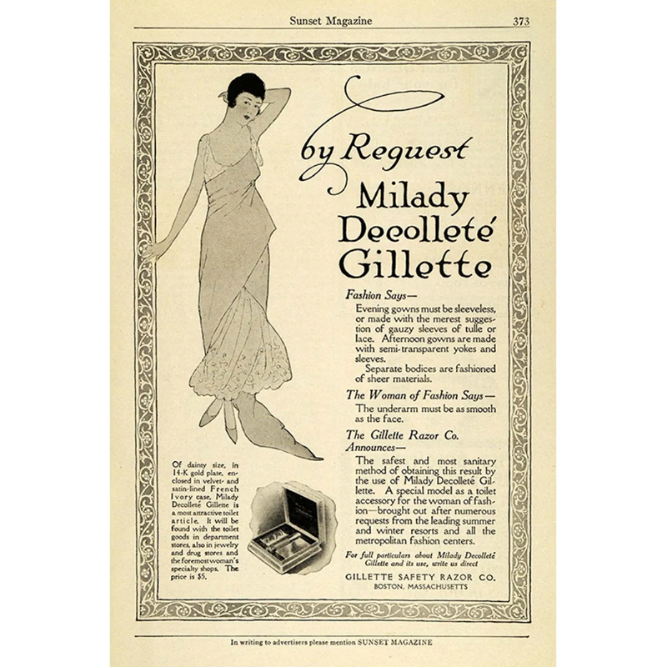Shaving Herstory: A brief reflection on where it all began.
As I researched in preparation for this article, I couldn’t help but think back on where it all began for me. I certainly haven’t always been a traditional wet shaving enthusiast of sorts. In fact, I had given very little thought to shaving at all for many years. I do know, however, that like many women, I started shaving at around 12 years old. For me, specifically, by the prompting of my older sisters after keenly observing my “unsightly” blonde leg hair that had made its appearance that summer. I never even noticed my stupid leg hair. Big deal. But I did it anyway without ever watching a woman shave, without a tip or tutorial…just some “advice” from my older sisters eager to pick on my childish notions of beauty standards, of which I was oblivious.
Evidence of female hair removal can be traced to the stone ages and ancient Egypt/Rome. Depilatories, beeswax, and shells were used to remove hair primarily for purposes relative to cleanliness (Cerini, 2020). Other ancient societies correlated the appearance of smooth skin with symbols of status and purity (Cerini, 2020). Even Darwin is cited as associating body hair with primitive ancestry and a lack in evolutional development; theorizing that a smaller amount of body hair is derived from notions of evolutional superiority (Cerini, 2020). What a tangled hairy web we weave, Darwin.

Image: Milady Décolleté by Gillette featured in Sunset Magazine, 1915
Changes in women’s fashion in the 20th century brought about opportunities for shaving manufacturers to appeal to a new demand for hair removal products. Marketing strategies altered the narrative for women and heavily influenced beauty standards around body hair exposure. In 1915 the first women’s safety razor, Milady Décolleté, was released by Gillette. Adverts boasted the razor as a new solution for an “embarrassing personal problem” (hairy armpits) and was promoted as an essential fashion accessory for the “modern woman”. Advertising for women’s razors/depilatory products profoundly shaped expectations of female hair removal as a commonplace part of womanhood (Komar, 2016). Shaving companies sought to promote a message that translated smooth, hairless skin to public ideals of delicate femininity often by referring to body hair as “objectionable”, “unsightly”, and “ugly” (Komar,2016).

Image: Ashes and Roses Depilatory advertisement featured in Harper’s Bazaar, 1922
The roaring 20’s brought legs into the game with shortened hemlines. Thanks to panty hose, the call for hairless legs did not come into play until WWII. With pinup images on the rise, and hosiery shortages, we were reduced to shaven legs, makeup, and sensual poses as a right to American womanhood. Just kidding, kind of. From here on out shaving amongst women in the U.S. became a widely anticipated practice, and according to an interview with Bustle (2016), Rebecca Herzig, the author of of Plucked: A History of Hair Removal , stated that "By 1964, surveys indicated that 98 percent of all American women aged fifteen to forty-four were routinely shaving their legs." That my friends, is the short version of how American women came to shave. The rest is herstory.
LP
Sources
Cerini, M. 2020.Why women feel pressured to shave. Retrieved March 20, 2021, from https://www.cnn.com/style/article/why-women-feel-pressured-to-shave/index.html
Komar, M. 2016. The sneaky, manipulative history of why women started shaving. Retrieved March 20, 2021, from https://www.bustle.com/articles/196747-the-sneaky-manipulative-history-of-why-women-started-shaving

